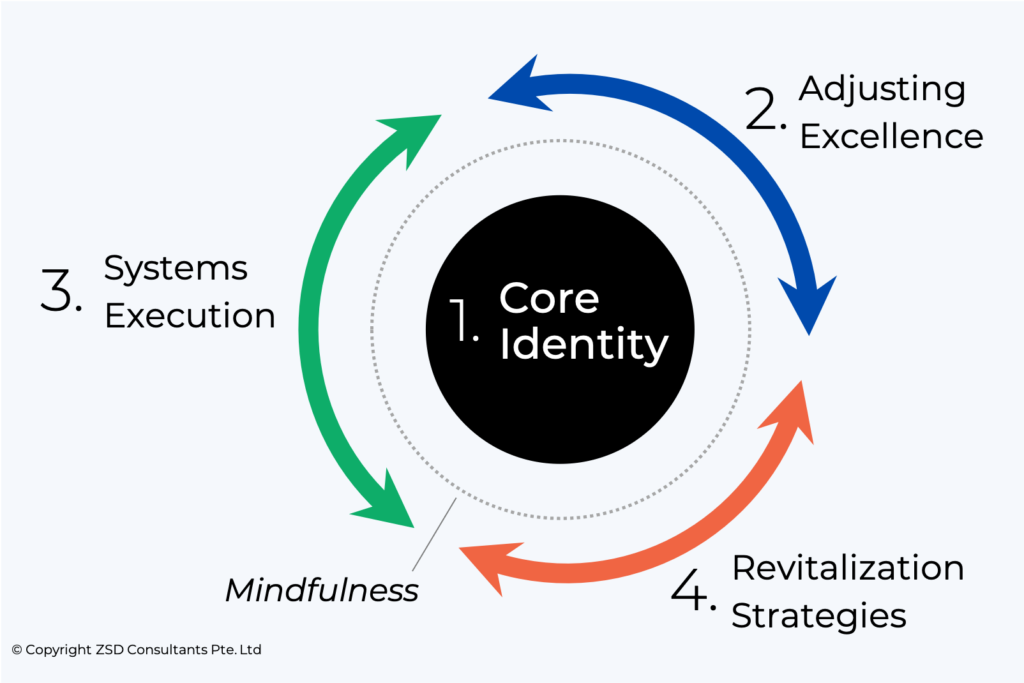Pillar Four: Your Revitalization Strategies
Let’s continue our introduction of the Four Pillars of Sustained Success in Practice. In the last three articles, I introduced the first three Pillars that form the foundation of ADIO Chiropractic Coaching.
To review, the three pillars are:
Feel free to review those articles to get a better understanding of our approach to coaching Chiropractors and general practice management.
In this article, let’s move this discussion forward and introduce Pillar Four: Revitalization Strategies.
Here’s another reminder of the big-picture model I’m referring to:
The Four Pillars of Sustained Success In Practice

Again, think of this model as the operating system of our approach to practice management and coaching Chiropractors.
What are Revitalization Strategies?
As the name implies, Revitalization Strategies are things you do on a regular basis to recover, recharge, and re-energize yourself; so you can perform at your best in your professional life. Revitalization Strategies help you to be maximally effective in your practice, and they allow you to sustain high-effort over time. Pillar Four is all about organizing your life in such a way that causes you to be the best version of yourself in your practice. The name of the game is sustained high-performance.
Inject Life into Your Life
Why are Revitalization Strategies important? Leading a busy, high achieving practice—especially if you see a high volume of patients—doesn’t just happen by accident. It requires a significant amount of energetic output by you and your team. For your practice to continue to thrive over the long haul, you need to consistently apply, measure, and calibrate the specific strategies that drive the operation of your practice. You will experience great rewards as you move closer to your Vision of Success in your practice, but, at times, there will be a price to pay.
There will be issues to address, areas to improve, and ‘fires’ to put out. You will have setbacks, staff challenges, and maybe personal problems along the way that can adversely affect your ability to perform in your practice. These challenges can drain your energy, leading to significant stress and, if you allow them to persist, can cause burnout.
There will always be stresses and challenges that deplete your energy. This ‘negative momentum’ is unavoidable. It is a natural part of having a big vision for your practice and being committed to fulfilling your potential. Being aware of this fact is the first step in safeguarding yourself from the pitfalls that can come from demanding high standards.
At the same time, it is critical that you actively do things on a daily basis to counteract this negative momentum and inject generative energy back into your life, so you can cultivate the internal resources needed for you to lead your team and powerfully serve your patients.
Stress is a part of being in practice. I encourage you to be proactive in combating the negative effects of stress. This is a major reason Revitalization Strategies are such an important part of the ADIO Chiropractic Coaching system. Having these strategies alive in your life is crucial for sustained success.
Being Healthy is a Job Requirement
Too many Chiropractors make the wrongheaded choice (maybe subconsciously) to sacrifice their health and vitality while trying to build a busy practice. They hold themselves up to an external standard of what they think they should be achieving, and grind, and grind, and grind to try and get there. They think that they need to put in the brute force of this unrelenting effort to reach their dreams.
Work hard, but do not make this mistake. You can only sacrifice yourself for your practice for so long. Eventually the bill will come due and you will need to pay up.
Neglecting your own health—your physical, mental, emotional, and spiritual health—will catch up to you. I have seen it far too many times in our profession. Chiropractors get obsessed with chasing the brass ring of achieving a certain volume or a specific level of revenue; all at the cost of their relationships, fitness, diets, and then an ‘unforeseen’ crisis shows up. They are then forced to drastically disrupt their lives, causing even more distress and trauma—sometimes to catastrophic ends.
Their practice, the thing they spent so much of their energy trying to build, falls apart because it was built on an unsustainable foundation. It’s like they were driving 100 miles per hour without checking to see if they had petrol in the tank.
If you want a healthy practice—you need to be healthy.
Don’t get me wrong, I highly recommend having goals and working very hard to build a practice you love. But this effort needs to be aligned with your authentic self, and you cannot sacrifice your health to achieve your Vision. The work of fulfilling your potential in your professional life needs to be in harmony with the totality of your life. Work hard. Put in the time. Yet, your practice cannot be at odds with the rest of your life.
You need to be an avatar of health and vitality. Prioritize this aspect of your life; don’t neglect it. If you are overweight and need to improve your fitness, get to work. If you are undisciplined with your diet, improve in this area. If you are making excuses, blaming other people, and having a negative attitude towards your professional life, stop this ‘stinking thinking’ right now.
More than likely, you already know what you need to do or stop doing to be healthier. It is time to gain traction in this area. Full stop. Do what needs to be done to improve your health and vitality.
You are More than a Chiropractor
Your professional life is not the only factor that defines who you are. It is also important to nourish other dimensions of yourself, other than your identity as a Chiropractor leading your team. You are more than a Chiropractor. You are a person that does Chiropractic. It may not always seem like it, but Chiropractic is not the alpha and omega of your life.
Your professional life should not consume all aspects of your existence. It may be the main driver of your identity, the area of your life that provides you with the most certainty and personal power. But you need to make sure that you achieve harmony across all dimensions of your life. Without harmony, you will lose momentum—like a bicycle with a flat tire, it will take a lot of effort to gain ground. Eventually you’ll get stuck.
It may seem counter-intuitive, but by nourishing and cultivating different aspects of yourself, you will increase the internal resources you can tap into, to continue to perform in your practice. Strengthening who you are in totality as a person will allow you to bring more authenticity to your role as the leader of your practice. More success and fulfillment will naturally follow.
Balance Work and Recovery
If you have a clear and significant Strategic Vision of where you want to go in your professional life, then you will need to work diligently to become the best you can be. This will lead to some level of stress and difficulty. That’s a fact. There is no correlation between working at something less and getting better at it. As with most things however, there needs to be some level of balance between work and recovery.
Consider the following formula:
Stress + Adequate Recovery = Growth
Work hard, but do not neglect your rest and recovery. This is the whole point of Pillar Four: Revitalization Strategies. If you are committed to growing your practice and maximizing your capabilities as a leader, you will need to venture beyond your zone of comfort. You will need to stretch yourself and, at times, run into the barrier of your limits. But don’t overstretch yourself. Don’t spin your wheels too long in the zone of high output and diminishing returns.
Always allow for adequate time to recharge, recuperate, and recover.
Below, you’ll find a number of concrete recommendations to guide you in developing your own Revitalization Strategies. These recommendation are here to help you reach peak performance and sustain excellence.
Get Adjusted!
This recommendation almost goes without saying—get adjusted! It is very important for your overall health and vitality to get your spine and nerve system checked and adjusted on a regular basis. Your regular adjustments should be an integral part of your Revitalization Strategies. Commit to rhythm, repetition, and consistency with your adjustments so you can be at your best in your professional life.
Don’t Neglect Your Hobbies
Don’t let your intense focus on building your practice completely crowd out the hobbies you enjoy. By hobbies, I don’t mean going to the gym or your exercise regime—you do these for your health. I’m referring to sports, activities, or other pastimes that you do just for the pure fun of it; without any other motive other than enjoyment.
Your hobbies should be completely separate from your practice. Ideally, it would be great if you engage in hobbies that don’t involve other Chiropractors. It’s good to get out of the Chiropractic bubble from time to time. Although, this may be easier said than done.
Think of your hobbies as your ‘me-time.’ Cultivate passions and activities outside of Chiropractic that feed your soul. It’s important to disengage from your practice and recharge by doing things you love to do—just because you love to do them.
Be Joyful in Your Practice
Regularly remind yourself to savor the joy that is present in the day-to-day experiences of your practice. The more you focus on something, the more it will show up in your life. Focus on being joyful and you will attract more joy, meaning, and fulfillment into your life.
What specific aspects of your practice generate the most joy for you? Pay attention to these areas and experiences. They are likely elements of your practice that you are naturally good at and that you value. They are probably areas that you could leverage into world-class results with sustained attention. Your joy is a window into your values and your Core Identity more broadly.
Be the type of charismatic leader that radiates joy and optimism regularly. Your patients and your team will be more attracted to you. Expressing a joyful state of being is a skill that can expand and develop with attention and effort. Build this muscle by focusing on it. After all, if you don’t experience joy in your practice, what’s the point?
Adopt an ‘Attitude of Gratitude’
Another great recommendation is to adopt an ‘attitude of gratitude.’ Slow down, and be grateful for the wonderful things in your life. Count your blessings, and experience the positive emotions associated with being grateful.
I also recommend starting a gratitude journal. On a daily basis, maybe at the end of your day, simply write down the top three things that occurred that day that you are grateful for. This simple act will more firmly establish a state of gratitude in your psyche.
At the same time, you don’t have to tangibly have or experience something in order for you to be grateful for it. In fact, imagining the outcome—mentally rehearsing its existence—before it is present, will actually increase the likelihood that you will manifest the outcome or result into your life.
Be grateful for the things you have and the things you will have.
Master Your Mornings
The most successful people on the planet ritualize their morning routine to prime themselves for peak performance. How you spend your time before you go into your practice in the morning will go a long way in determining how fruitful your day will be.
Does your morning routine cause you to have the internal resources available for a great day of service? Or does it add stress to your day and diminish your ability to excel in your practice?
We are all a little different in this area, but here are some general recommendations to help you master your mornings:
- Wake up early, at least 60 to 90 minutes (or more) before you leave the house in the morning to go to your practice.
- Eliminate social media—especially Facebook and Instagram— in the morning before you go into your practice.
- Don’t look at your mobile phone for the first 30 to 60 minutes of your mornings.
- Delay your first coffee by 60 to 90 minutes. Eliminate coffee altogether if you want to.
- View sunlight for 10-20 minutes.
- Exercise. It is critical that you move your body, expend energy, and break a sweat before you arrive at your practice. Exercise will reduce your stress, improve your mood, and energize your day. It is the single most important thing you can do in the morning to optimize your performance.
- Meditate.
- Engage in active visualization.
- Do deep breathing exercises.
- Hydrate.
- Eat a nutritious breakfast; high-quality proteins and fats. Low sugar content. Lots of raw fruits and vegetables.
- Listen to uplifting music, maybe dance if you are moved to.
- Hug the humans and animals you love.
Take Vacations and Holidays
It is also important that you prioritize getting away and taking regular vacations. I recommend taking at least 2-4 weeks of vacation per year. Getting away from your city/ town and out of your practice will clear your head and allow you to deeply recharge and revitalize.
Categories of Revitalization Strategies
Let’s look at four broad categories you can draw from as you build out your own Revitalization Strategies. I think of these as the Four Buckets of Revitalization Strategies.
1. Move Well
As a Chiropractor, I would be shocked if you did not believe that ‘motion is life.’ This obviously applies to you as well. A strong, fit, healthy body is critical for sustained high performance in your practice. To that end, here are some ideas to consider:
- Get Adjusted regularly. Enough said.
- Regular exercise is crucial. The type of exercise you do doesn’t matter as much as the consistency with which you do it.
- A combination of strength, functional, interval, and cardiovascular training is great.
- Core strengthening will help reduce the risk of injury while adjusting.
- Whatever type of exercise you do, it is important that you enjoy it. Make sure you work up a sweat daily.
- Stretch regularly. Work to maintain optimal range of motion, flexibility, and posture.
- Stay focused on having great posture, ergonomics, and biomechanics while you are adjusting patients. Be aware of repetitive, unilateral movements.
You probably already have a lot of knowledge in this bucket.
2. Sleep Well
- Aim for 6-8 hours of uninterrupted sleep per night.
- No screens: TV, phone, iPad, etc.
- Eliminate all blue light in your bedroom.
- Use an old-school alarm clock.
- Keep the environment cool.
3. Eat and Hydrate Well
- Adopt an anti-inflammatory diet.
- A low sugar diet is a very good place to start.
- Ingest lots of leafy greens and colorful, raw vegetables.
- High quality, healthy fats are important.
- High quality animal protein can be important as well.
- Consume a limited amount of processed and refined foods.
- Hydrate continually throughout your day.
4. Think Well
It’s critical to disconnect from the stresses of your practice and refresh mentally and emotionally on a daily basis. Here are a few recommendations:
- Engage in a regular practice of meditation or breathwork. This allows a state of inner stillness to be present in your daily life more consistently.
- Cultivate positive states of mind like optimism, enthusiasm, joy, gratitude, calm, peace, confidence, focus, grit, personal responsibility, growth mindset, etc.
- Invest in teachers, coaches, books, courses, podcasts etc.
- Read widely.
- Seek out new experiences and explore fresh ideas.
- Play and celebrate regularly.
- Give energy to your healthy relationships.
This bucket is all about you prioritizing your cognitive, mental and emotional health. If you think well, you will likely feel well. The better you mentally and emotionally feel, the better you will perform in your professional life.
Don’t Fall into the Same Old Trap
I want to end this article with a warning. It is far too easy to put all of your effort and energy into the work of building your practice and neglect your Revitalization Strategies. I have seen successful Chiropractors walk this dangerous path far too often. In fact, early in my career I was guilty of charging hard up the mountain of practice growth while neglecting my mental, emotional, and physical health. I was fortunate to realize that the way I was conducting my life at that time was not sustainable and I made significant changes. Many of the insights that I gained from my early setbacks have directly led to the ADIO Coaching system.
Yes, do the work of defining, clarifying, and developing certainty of your Core Identity in practice. Put in a huge amount of effort to become a master adjuster. Pay the required price to fully develop your Systems, Procedures, and Operation. But do not sacrifice yourself on the altar of your practice. Do not make this mistake.
When a physical complaint or an emotional breakdown becomes a distraction, it will hijack your mental performance. Your practice will inevitably suffer as a result. This is why Pillar Four: Revitalization Strategies holds its own distinct position within ADIO Chiropractic Coaching’s model of Sustained Success in Practice. It is easy to overlook this crucial pillar as you drive your practice forward. I highly recommend that you establish these fundamental strategies early in your career and revisit them often.
Develop your mind, your body, and your craft on your path of mastery. At the same time, prioritize your Revitalization Strategies to safeguard your livelihood, and to ensure that your practice will thrive far into the future.
-DZ




